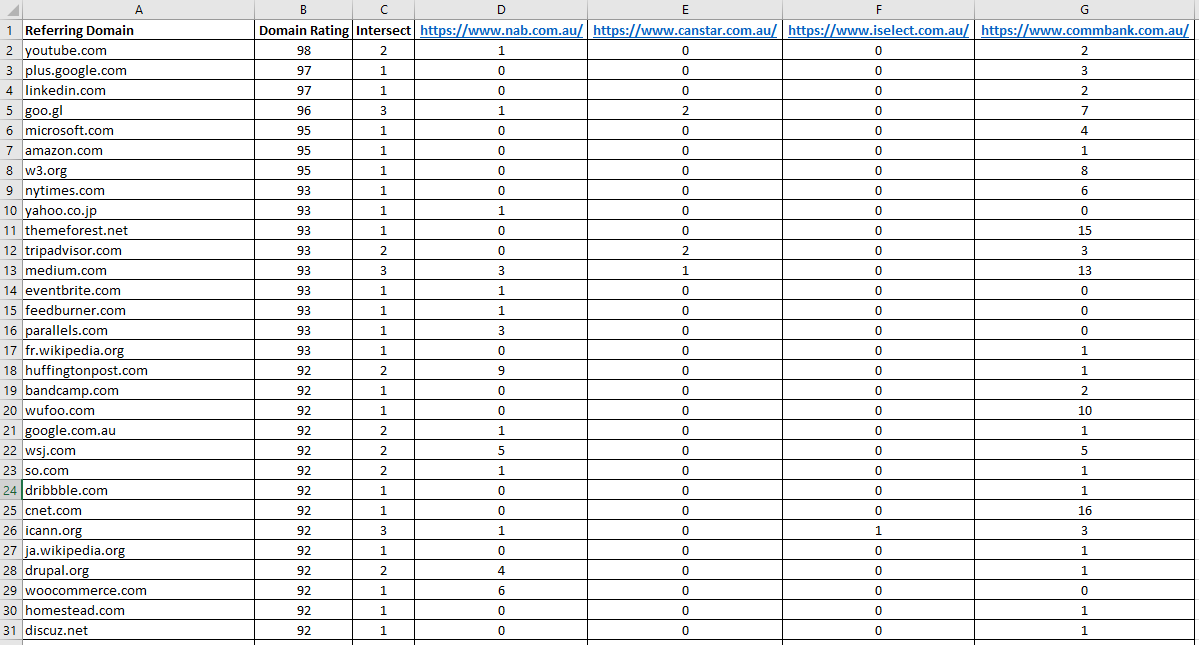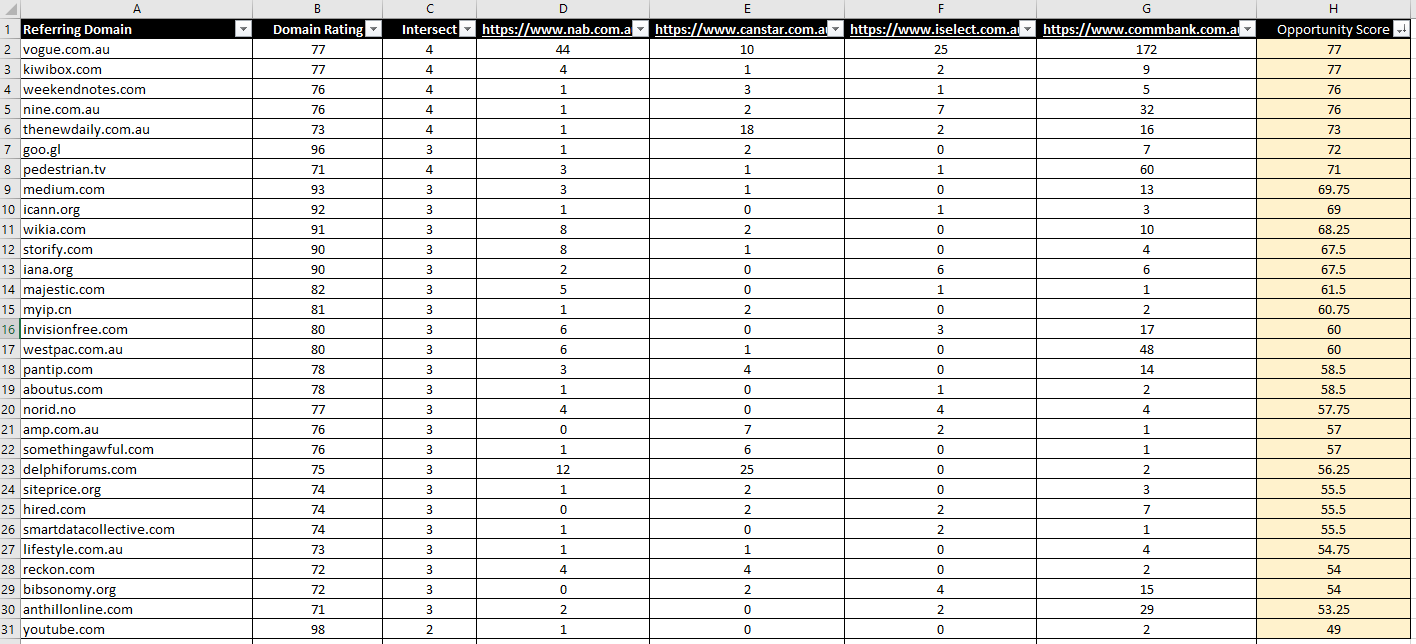Contents
SEO is a well-renowned necessity – but very rarely do small business owners know how useful it is for your small biz exposure. And in the fragile stage of being a small business – everyone is competing for their spot in the SERPs.
Link building can be the very difference in your site appearing on page 1 or page 100. As a small business, dwarfing competitors in the race for higher positions relies heavily on a well-crafted backlink strategy. This guide discusses spying on and investigating your competitor’s link building exercises. After learning their successful link building secrets, you can devise your own and acquire greater organic traffic and conversions – how 007 is that?
-
Ranking competitors by share of voice
Begin your backlink journey by determining the top nine competitors from your share of voice results. Only direct competitors are relevant here so remember to cull any non-commercial (Wikipedia), editorial (New York Times), or social communities/review sites (Trip Advisor). The remaining list should only include sites offering the same services as your business.
In SEO, a share of voice report approximately translates your brand’s amount of visibility for one or more keywords as compared to your competition. Basically, if you report a higher SoV % than your competitors, then you are ranking for more keywords than them.
For demonstrative purposes, here is an example of how SoV results for the Australian finance industry might look. The green and red figures highlight the SERPs visibility change over the four-month period.

Credit: Indago Digital
Share of voice is another chapter altogether, so here’s an expert guide for more information.
- Discover websites linking to your competitors
A link intersect can successfully help identify whether a website is linking to a competitor’s but not yours. There are possibly hundreds of these link-distributing websites – it all depends on the number of links your competitors have built.
A list of these websites can be analysed by importing the URLs of competitor websites (based on share of voice) into Ahrefs. We can therefore analyse the number of websites linking to three or more of your competitors.
The Ahrefs Link Intersect tool simplifies this process by creating a report which contains a tally of intersects (the common denominator websites). Your aim should be to include between 5-10 competitors and then download the data into an Excel document. An alternative route is that you can extract the total referring URLs of SoV competitors and create a pivot table (this again is a longer chapter in itself).
Below is a screenshot of the initial results.

An important thing to highlight is that there are 12,000 results and the domain rating of the urls vary wildly. To order the report by ranking, the results can be refined by toggling the domain rating to show the higher value opportunities, as in websites with a domain rating of 30 and above.
- Extracting your competitor backlink profiles
We can then export the top 1,000 results and open the exported sheet as an Excel spreadsheet. It is recommended to allocate filters to the top row and designate columns from left to right as follows: referring domains; domain rating; intersect tally, and each of the competitor websites. The data can be refined again by deleting all duplicate entries.

- Calculating backlink opportunity scores
We can now rank these opportunities by their importance by calculating their backlink opportunity score. The higher the scores are, the more valuable the opportunities are. To calculate this, multiply the domain rating by the number of intersects and divide by the total number of competitor sites. An Excel formula actioning this would look something like the following: =SUM(B2*C2)/4.
The results should look different as per below…

- Defining the backlink tactics
The final stage includes understanding exactly why your competitors’ backlinks were published on these sites and how. Your motivation here is that if their backlinks were published because of reason x, then there’s no reason that yours can’t be either.
There are machines which can categorise websites by type to save time, but it’s best perhaps to not use shortcuts. Breaking down competitor backlink profiles involves manually investigating the URLS where the backlinks rest. It involves the human touch – aka common sense.
There are two ways you could run a URL check:
The first way is using Google search commands to see on which pages on the target site our competitor link appears; the second involves running a search through the backlink profile of the website within Ahrefs. You’re better-off going the second route as it is more likely to provide the more accurate outcome.
The more prominent nature of the competitor sites, the more likely it is that the opportunity tactics will involve more news coverage and article submissions. Conversely, the less prominent, the higher the number of forum and directory link opportunities will exist.
Our aim here is to construct a list of tactics which can be used to label our opportunity strategies by and I’d expect the following outcomes to be on your list:
- News coverage
These backlinks are earned through merit; larger publications (such as News Corp) will directly reference brands within stories as the author of a data study or press release. These backlinks are extremely difficult to achieve.
- Article submissions
These backlinks are included within blog articles or features written on behalf of the business or through the authoring of a marketer who includes a backlink within their content piece as a reference to your brand. This is difficult to achieve, unless you’re paying for the privilege.
- Personal blog submissions
These backlinks are achieved when collaborating with a blogger in your industry to formulate content which can then link back to your website in exchange for cooperation or assistance.
- Partner network submissions
These backlinks are given out within footers or testimonial pages to validify the user of an existing professional relationship with your business.
- Directory submissions
These backlinks are inclusive in the listings of your company profile within a business directory (local or global). This can however be frowned upon in the industry as directory sites are prone to spammer-use.
- Forum submissions
These backlinks are included in live conversations within a forum thread and can be in the context of reaching your website for further information. Not unlike directories, this falls into the ‘frowned-upon’ link building tactic.
- Visual content and social media submissions
Backlinks acquired from profile by-lines on social media platforms and video submission websites. Ideally, this is via the official brand channels. This is more of a brand awareness tactic than anything else.
Finally, tally the total number of results for each opportunity type in your Excel document and filter by highest to lowest opportunity score. Use this ranking system to guide you on prioritising which websites you hunt down for backlinks over any given set timeline.
“The opinions expressed by BizWitty Contributors are their own, not those of BizCover and should not be relied upon in place of appropriate professional advice. Please read our full disclaimer."







